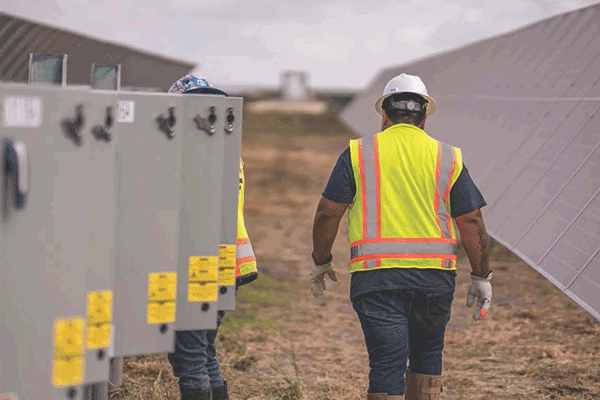Given the heavy reliance of electric vehicle (EV) charging stations on electricity, ensuring the reliability and affordability of power is paramount. However, the current situation is not always ideal. With extreme weather events becoming the new normal, large-scale and prolonged power outages are becoming increasingly common. Moreover, due to rising demand, new emission regulation policies, and overdue infrastructure upgrades, the cost of electricity in many parts of North America continues to climb.
Establishing an energy resilience strategy has become crucial, not only to ensure your charging station business remains unaffected by power grid disruptions but also to help you navigate the risks posed by market and regulatory changes. In most cases, “energy resilience” refers to the ability to maintain power supply during localized outages. However, organizations can and should enhance the resilience of their energy strategies in various ways to minimize risk as much as possible. Key considerations in formulating a strategy include operational resilience, economic resilience, and regulatory resilience.

Operational Resilience: Staying Online During Grid Disruptions
Operational resilience allows facilities to continue relying on energy processes during grid disruptions. This form of resilience is increasingly critical—over the 20 years following 2000, the frequency of major outages increased by 67%, with expectations for further increases due to extreme weather conditions. In 2022 alone, 18 extreme weather events each caused $1 billion in damages, including a drought, a flood, eleven severe storms, three tropical cyclones, a wildfire, and a winter storm.
A variety of solutions can help organizations ensure operational resilience, offering a range of durations to meet the needs of different sizes of energy loads. When selecting solutions, organizations must prioritize various factors, including the size and duration of the load, cost and economic savings, as well as sustainability values. It’s critical for organizations to understand the frequency and duration of potential downtimes, along with the associated costs per hour of facility downtime. Beyond the obvious lost revenue costs, there are also hard-to-quantify costs such as non-productive labor and waste.
Economic Resilience: Maintaining Stable Energy Prices Amid Fluctuations
Beyond the continuity of power, organizations must ensure their energy strategy can adapt to economic uncertainties and fluctuations. Over the past decade, tariff rates for large energy users in certain regions of the U.S. have undergone significant changes, growing at a pace noticeably faster than inflation.
This is just one of the numerous economic challenges of recent years. Now, after two years of energy volatility due to price and supply chain shortages, many organizations are prioritizing the minimization of future pricing risks. Reducing management costs is crucial for operational excellence, as the energy prices organizations pay directly affect the services and products they offer.
Regulatory Resilience: Reducing Emissions as Stakeholder Demands Increase
The regulatory landscape is rapidly evolving. Regulatory and legislative bodies are elevating sustainability requirements, investors and stakeholders are demanding more action, and reporting standards are continuously developing.
For instance, in 2022, the U.S. Securities and Exchange Commission (SEC) introduced new Environmental, Social, and Governance (ESG) disclosure requirements, mandating public organizations to enhance and standardize climate-related disclosures. The simplest way for many organizations to prepare for these changes is to start now. Integrating technologies that enhance sustainability and reduce carbon emissions can enable organizations to adapt to any regulatory shifts that may occur.
Solutions Suitable for Various Forms of Energy Resilience
Backup Generators
Backup generators, typically powered by diesel, natural gas, or propane, are a classic example of energy resilience. Although they are often the cheapest entry option, they possess negative sustainability values and may face the risk of asset stranding if carbon restrictions are implemented in the future. Organizations prioritizing sustainable development should consider other options.
Energy Storage
Energy storage allows for the retention of electricity for on-demand use—enabling organizations to shift their demand from times when microgrid costs are highest to when they are lowest.
Microgrids
In engineering terms, microgrids represent the most complex solution for resilience. They can utilize any combination of distributed generation, such as solar, wind, fossil fuel generators, storage, and resilient hardware. Depending on their scale, they can enable organizations to continue operating for hours, days, or even weeks during grid outages. However, this level of resilience is costly and requires an evaluation based on the benefits of having such a system. Microgrids are most suitable for organizations that would incur significant losses (financial or otherwise) if operations were interrupted due to power outages.
Solar
On-site solar power systems are a potent renewable energy solution, often offering good return on investment. On-site solar comes with various financing options, allowing for immediate cost savings in the first year, as well as long-term savings over the 20 to 30 years of the solar system’s power generation. On-site solar also serves as an important hedge against rising energy prices and volatility.
Power Purchase Agreements (PPAs)
PPAs are agreements between a buyer and a seller of electricity. In a physical PPA, a buyer contracts with a developer to purchase physical power and associated renewable energy credits. PPAs exemplify economic resilience, offering a hedge against blackout-related operational resilience issues.
PPAs can secure an organization’s energy prices for up to a 25-year period, shielding them from potentially much higher future prices. The 2020s have demonstrated the volatility and escalation of energy prices—organizations that secured prices with a PPA before 2020 have reduced volatility and, in many instances, decreased their energy expenses.
Virtual Power Purchase Agreements (VPPAs)
VPPAs are a variant of physical PPAs, functioning as financial transactions that provide the buyer with the environmental and economic benefits of a renewable energy project, while the electricity generated flows to the grid. VPPAs facilitate large-scale decarbonization more efficiently than on-site generation. Depending on the load, VPPAs can enable an organization to fulfill 100% of its renewable energy requirements. A single contract can encompass hundreds or potentially thousands of facilities.














